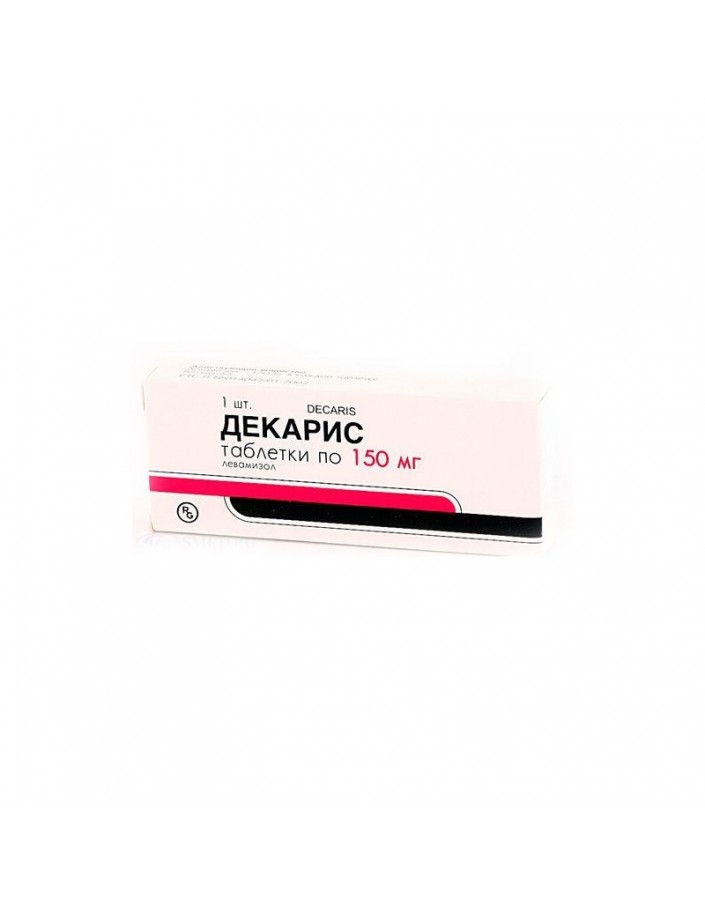




Security policy (edit with Customer reassurance module)

Delivery policy (edit with Customer reassurance module)

Return policy (edit with Customer reassurance module)
| pharmachologic effect
Anti-worming agent of a broad spectrum. Paralyzing helminths, causing depolarization of the membrane of their muscles, blocks succinate dehydrogenase, inhibits fumarate reductase, disrupting the course of the bioenergetic processes of helminths. It has an immunomodulating effect: it increases the production of antibodies to various antigens, enhances the T-cell response, activating T-lymphocytes, stimulates their proliferation, enhances the function of monocytes, macrophages and neutrophils (their ability to chemotaxis, adhesion and phagocytosis). Rapidly absorbed from the digestive tract. Cmax - 0.13 mcg / ml, TCmax - 1.5-2 hours T1 / 2 - 3-4 hours, metabolites - 16 hours. Metabolized in the liver with the formation of inactive metabolites, which are excreted mainly by the kidneys (70%) within 3 days. About 5% is excreted in the bile, with only 0.2% unchanged. By the kidneys, 12% is excreted as glucuronide-p-hydroxylesteamisole and 5% in unchanged form. Indications and usageAscariasis, hookworm, necatoriasis, strongyloidosis, trichostrongylosis, trichocephalosis, enterobiosis, toxoplasmosis. ContraindicationsHypersensitivity, pregnancy, lactation; agranulocytosis caused by drugs (including in history); children's age (up to 14 years). With caution - hepatic and / or renal failure, inhibition of bone marrow hematopoiesis, cerebrovascular failure,acute phase of leukemia. Inside, while eating. Toxoplasmosis: 150 mg / day at a time for 3 days (2-3 courses with intervals of 1 week). Helminthiasis: once, at bedtime - for adults 150 mg, for children - at the rate of 2.5 mg / kg. If necessary, a second course after 1 week. Adverse reactionsOn the part of the digestive system: nausea, vomiting, diarrhea, abdominal pain, pancreatitis, increased activity of alkaline phosphatase; rarely, ulceration of the oral mucosa. Nervous system disorders: headache, paresthesias, peripheral polyneuropathy, olfactory hallucinations, generalized convulsions, encephalitis-like syndrome (associated with demyelination of nerve fibers), impaired speech, lethargy; rarely - fatigue, tremor, sleep disturbances, confusion, ataxia. From the side of blood-forming organs: leukopenia, agranulocytosis. On the part of the urinary system: kidney damage, hypercreatininemia. Allergic reactions: skin rash, exfoliative dermatitis. Other: uterine bleeding, periorbital edema, muscle weakness; rarely - a perversion of taste; extremely rare - iridocyclitis, vasculitis, lymphadenopathy. Special notesBefore starting treatment, a study of peripheral blood should be carried out; during therapy - control of the number of leukocytes in the blood. Infectious diseases (recurrent herpes, shingles, warts, chronic active hepatitis B, persistent viral hepatitis (for which HBsAg is determined for more than 3 months),recurrent sinusitis. Previously used as an immunomodulatory agent in immunodeficiency states, immune-dependent, including autoimmune diseases: rheumatoid arthritis, Crohn's disease, Reiter's disease, aphthous stomatitis, SLE (to maintain remission); malignant neoplasms of the bronchi, colon (including Duke colon cancer - adjuvant therapy after colon resection), mammary glands (after surgical, radiotherapy or chemotherapeutic treatment), remission in lymphogranulomatosis, in the cytostatic treatment of leukemia and lymphogranulomatosis chronic glomerulonephritis, chronic pyelonephritis, COPD, gastric ulcer and duodenal ulcer (often relapsing course). In the following doses: After removal of the tumor: 50 mg 3 times a day for 3 days in a row, every 2 weeks. Treatment begins at 7-30 days after resection and continues for 1 year (monotherapy or in combination with 5-fluorouracil). As an immunostimulating agent: 150 mg / day once or in 3 doses of 50 mg for 3 days in a row, every 2 weeks or 150 mg / day once a week (with regular monitoring of the number of leukocytes in the blood). The duration of treatment is set individually. Rheumatoid arthritis: 150 mg / day at a time (the effect develops after 3 months of therapy). HNZL: 150 mg / day every other day or 100 mg once a day every day. Chronic inflammatory diseases of the kidneys: 150 mg / day at a time 3 times a week.Peptic ulcer of the stomach and duodenum: 2-2.5 mg / kg / day at a time for 3 days (2-4 courses with intervals of 5-6 days). Drug interactionsNot compatible with lipophilic compounds, ethanol (may develop disulfiramopodobnogo syndrome) and agents that cause leukopenia. Enhances the effects of phenytoin and indirect anticoagulants. |